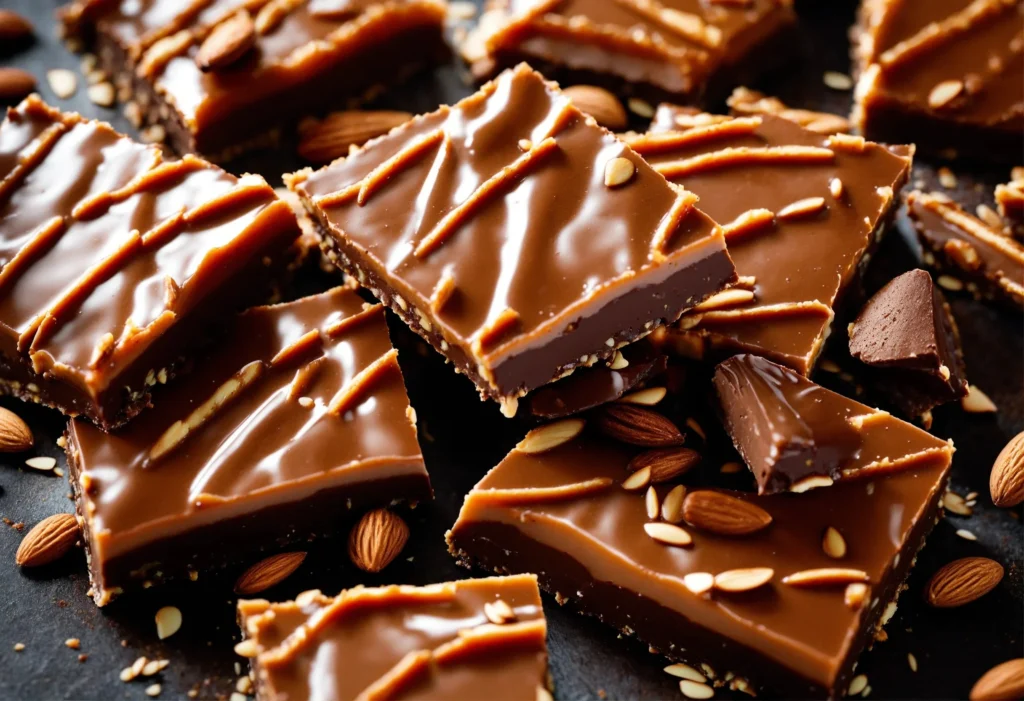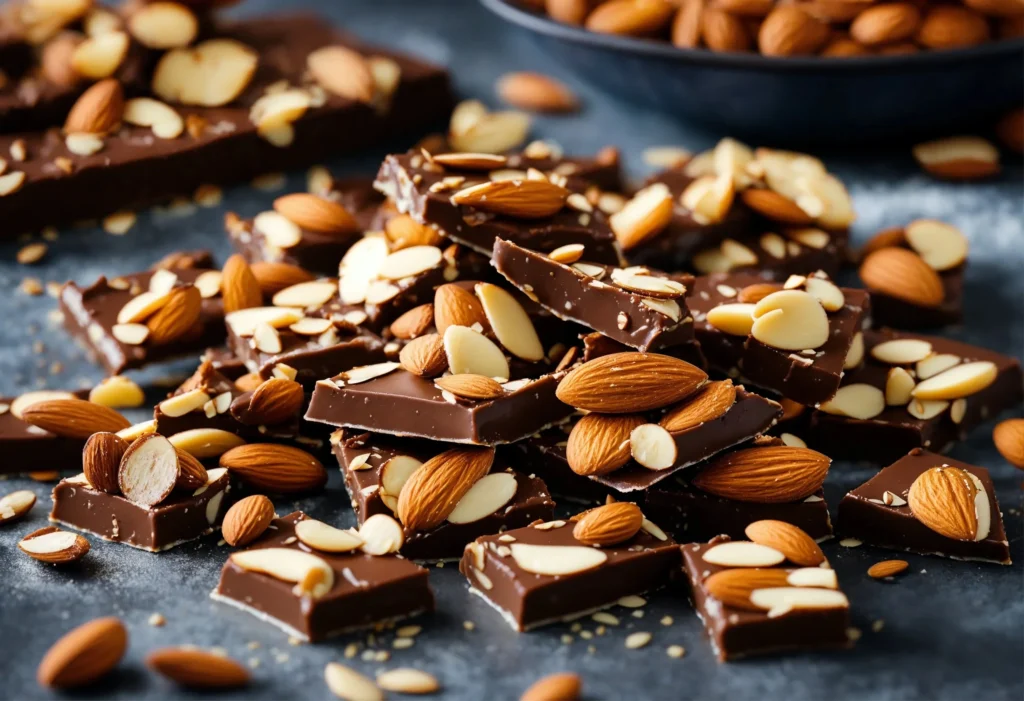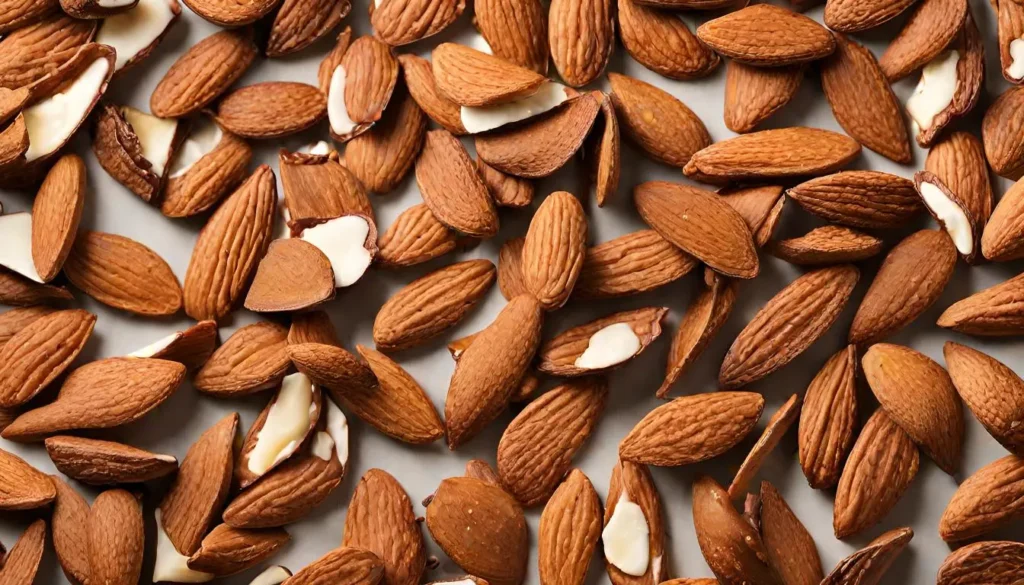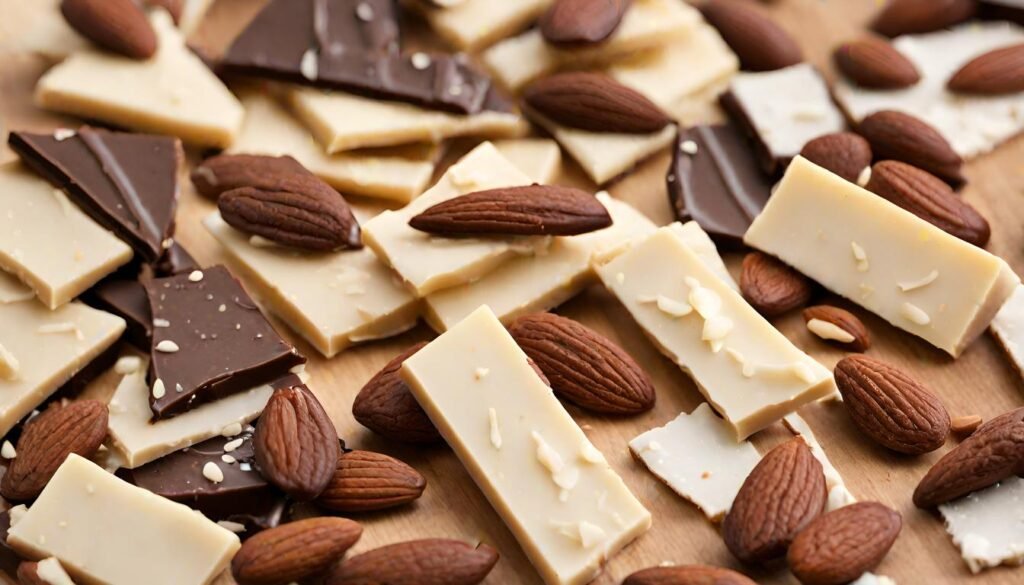
Almond bark, often overshadowed by its more famous counterparts like chocolate and caramel, is a culinary chameleon in the world of sweets and treats. This versatile ingredient, made from a blend of sugar, oil, and flavorings, offers a world of possibilities for both novice and seasoned bakers. From dipping delights to baking enhancements, almond bark is a secret weapon in creating mouth-watering confections. In this comprehensive guide, we’ll dive into the many facets of Almond coating, uncovering its uses, tips for perfect results, and answering all your burning questions. Let’s embark on this delicious journey !
Understanding Almond Bark
What is Almond Bark?
Almond bark, a confectionery darling, is not what its name might suggest. There are no almonds in this treat! Instead, it’s a smooth, versatile coating made from a mixture of sugar, vegetable oils, and flavorings. Often used as a substitute for chocolate, Almond confectionery has gained popularity for its ease of use and adaptability in various culinary creations.

The Composition
At its core, almond bark consists of sugar and vegetable fats, unlike traditional chocolate that relies on cocoa butter. This unique composition allows it to melt smoothly without the need for tempering, a process often necessary for chocolate. Besides, the absence of cocoa solids in Melting bark gives it a neutral flavor, making it an ideal canvas for a range of flavor additions, from vanilla to peppermint.
In the realm of sweet treats, Almond coating stands out for its simplicity and functionality. Whether you’re a baking enthusiast or a professional confectioner, understanding the basics of Almond confection is the first step in unleashing its potential in your culinary adventures. Stay tuned as we delve deeper into the myriad ways to use Melting bark in your kitchen creations!

In the next section, we’ll explore the various culinary uses of Almond coating, showcasing its versatility in both sweet and savory recipes. Moreover, from coating fruits and nuts to enhancing baked goods, Almond confectionery is a kitchen staple that deserves a spot in every pantry. Stay tuned for more delicious insights !
Culinary Uses
Almond bark is a culinary chameleon, seamlessly blending into a variety of dishes and desserts. Also, its versatility makes it a favorite among home cooks and professional chefs alike. Let’s explore how this simple ingredient can transform your kitchen creations.
Dipping Delights
One of the most popular uses of almond bark is in creating delectable dipped treats. Its smooth texture and easy melting properties make it perfect for coating fruits, nuts, and even cookies. Imagine dipping strawberries or pretzels into melted Almond coating, then watching it harden into a glossy, irresistible shell. Additionally, The possibilities are endless – from classic chocolate-covered almonds to adventurous combinations like blueberries dipped in lemon-flavored Melting bark.
Baking
In baking, Almond confectionery is a game-changer. It can be used to add a creamy, chocolate-like coating to cakes, cookies, and pastries. In Addition, Drizzle it over a sponge cake for a simple yet elegant finish, or mix it into brownie batter for an extra layer of richness. Almond bark’s ability to hold its shape at room temperature makes it ideal for creating decorative designs on baked goods, adding both flavor and flair to your creations.
Creative Confectioneries
Almond bark isn’t just for dipping and drizzling; it’s also a key ingredient in homemade candies. From classic Almond confection slabs studded with dried fruits and nuts to festive holiday treats like peppermint bark, the simplicity of Almond coating allows your creativity to shine. It’s also a fantastic base for experimenting with flavors – mix in spices, extracts, or even a splash of liqueur to create your own signature confection.
In the next part of our guide, we’ll delve into the best practices for working with Melting bark, ensuring that your culinary endeavors are not just delicious but also visually stunning. Stay tuned for expert tips and tricks!
Almond bark’s versatility in the kitchen is truly remarkable. Whether you’re a seasoned baker or just starting out, it offers endless possibilities to enhance your culinary creations. In the following sections, we’ll continue to explore the many facets of Almond confectionery, including tips for achieving the best results and answering frequently asked questions. Stay tuned for more Almond confection adventures !
For a deeper understanding of almond bark and its comparison to other ingredients, consider reading this informative article on Her Curated Kitchen, which offers detailed insights into the world of almond bark and its culinary uses.
Tips and Techniques for Mastering it
Working with almond bark can be a delightful experience, but knowing a few key tips and techniques can elevate your creations from good to great. Likewise, let’s dive into some expert advice to help you master the art of using Almond coating.

Melting and Tempering
Melting almond bark is a breeze, but it requires a gentle touch. Well, the key is to use low heat and patience. You can melt it in a microwave, using short bursts and stirring frequently, or use a double boiler on the stove for more control. Remember, Almond confectionery can burn easily, so keep a watchful eye. Once melted, it’s ready to be used as a dip or drizzle. No need for the tempering process required for traditional chocolate!
Flavoring and Coloring
One of the joys of working with Almond confection is its adaptability. You can add various flavorings and colors to suit your taste or theme. Whether it’s a dash of vanilla extract for a classic touch, peppermint for a festive twist, or food coloring for a splash of fun, Almond confectionery takes on these additions beautifully. Just be sure to use oil-based or powdered colorants and flavorings, as water-based ones can cause the bark to seize.
Storing and Reusing
Proper storage of Melting bark is crucial for maintaining its quality. Keep it in a cool, dry place, away from direct sunlight. If you have leftovers after melting, don’t fret ! Besides, you can store it in an airtight container and gently reheat it for your next project. Almond coating can be remelted several times without losing its texture or flavor.
In the next section, we’ll compare almond bark to other ingredients like white chocolate and explore its role in vegan and gluten-free diets. Understanding these differences will help you make informed choices in your baking and candy-making endeavors. Stay tuned for more insightful comparisons and tips!
Almond Bark Compared to Other Ingredients
Almond bark is often used interchangeably with other confectionery ingredients, but understanding its unique properties and differences can enhance your culinary creations. Also, let’s compare Almond confection with other similar ingredients and discuss its role in special diets.

Almond Bark vs. White Chocolate
While Almond confectionery and white chocolate may look similar, they have distinct differences. White chocolate is made from cocoa butter, sugar, and milk solids, giving it a rich, creamy flavor and texture. Almond confection, on the other hand, is made from vegetable fats and lacks cocoa butter, resulting in a different mouthfeel and taste. For recipes where a more pronounced chocolate flavor is desired, white chocolate is the go-to choice. However, for a smoother, more neutral base that’s easier to work with, almond bark is ideal.
Almond Bark vs. Real Chocolate
Comparing almond bark to real chocolate, the key difference lies in the presence of cocoa solids in chocolate, which contribute to its characteristic flavor and texture. Furthermore, almond coating, lacking these cocoa solids, offers a milder taste and a different melting point, making it a preferred option for coating and decorating. It’s also more forgiving than chocolate, which requires tempering to achieve a glossy finish.
In your culinary journey, explore the simplicity of creating Dark Chocolate Almond Bark with only 3 ingredients. Check out the recipe here.
Vegan and Gluten-Free Considerations
For those with dietary restrictions, almond bark can be a useful ingredient. Most Melting bark is gluten-free, but it’s essential to check the label for any potential allergens or additives. However, Almond coating often contains milk solids, making it unsuitable for a vegan diet. If you’re catering to vegan or dairy-free requirements, look for specific vegan almond bark varieties that use alternative ingredients.
In the next part of our guide, we’ll address frequently asked questions about Almond confection. This section will provide valuable insights and tips, helping you to use Almond coating more effectively in your culinary endeavors. Stay tuned for our comprehensive FAQ section, where we’ll tackle all your almond bark queries !
FAQs
Almond bark is a versatile ingredient, but it often brings up a lot of questions, especially for those new to using it. Let’s dive into some frequently asked questions to demystify this confectionery staple.
Common Questions
How Do I Melt it for Optimal Results?
- Melting Almond confectionery is straightforward. Break it into smaller pieces for even melting and use a microwave or double boiler. In a microwave, heat in short bursts, stirring in between. On the stove, use a double boiler and stir constantly to avoid burning.
Can Almond confectionery Be Flavored and Colored?
- Absolutely! Almond confection accepts flavors and colors well. Use oil-based or powdered additives to avoid seizing. Experiment with extracts, spices, or food coloring to create unique tastes and appearances.
Is Almond confectionery Suitable for Candy Making?
- Yes, it’s excellent for homemade candies like truffles, bark, and chocolate-covered fruits. Its ease of use and smooth finish make it a popular choice for confectioners.
How Should I Store Leftover Almond confectionery?
- Store it in an airtight container at room temperature for up to two weeks. You can also refrigerate or freeze it for longer shelf life. Reheat gently when ready to use again.
Can I Use it for Coating Pretzels and Popcorn?
- It’s perfect for coating snacks like pretzels and popcorn. Its smooth texture and quick-setting properties create a delightful finish on these treats.
Tips from Experts
- When using Almond confectionery for dipping, ensure your fruits or nuts are completely dry to get a smooth coating.
- If you’re using Almond confection in baking, consider combining it with other ingredients like nuts or dried fruits to add texture and flavor.
- For a glossy finish, avoid overheating the Almond coating, as
this can cause it to become dull and clumpy.
In the next section of our guide, we’ll explore some exciting recipes and ideas for using Almond confection in your kitchen. From simple treats to elaborate desserts, Almond coating can add a touch of elegance and flavor to a wide range of dishes. Stay tuned for creative and delicious ways to incorporate almond bark into your culinary repertoire !
Cooking with Almond Bark – Recipes and Ideas
Almond bark is not just a versatile ingredient; it’s a source of inspiration for countless sweet creations. Whether you’re a baking novice or a seasoned pro, these ideas and recipes will help you make the most of this delightful ingredient.
Simple Recipes
- Classic Almond Bark: Start with something simple. Melt Almond coating spread it on a parchment-lined tray, and sprinkle with chopped almonds. Let it set, then break into pieces for a classic treat.
- Chocolate-Covered Strawberries: Dip fresh strawberries into melted Almond confectionalmond bark for an elegant and easy dessert. The smooth coating of Almond confectionery makes these a hit at any gathering.
- Almond Bark Pretzel Rods: Dip pretzel rods into melted Almond confectionery and roll them in sprinkles or crushed nuts. These are fun to make and even more fun to eat!
Creative Ideas
- Holiday-Themed Treats: Use colored Melting bark to create festive treats for holidays. Green for St. Patrick’s Day, red and white for Valentine’s Day – the possibilities are endless.
- Bark with a Twist: Mix things up by adding dried fruits, different nuts, or even cereal to your almond bark before it sets. Each bite offers a new flavor experience.
- Decorative Dessert Toppings: Melted Almond coating can be used to drizzle over cakes, cupcakes, or cookies for a professional-looking finish. You can even pipe it into shapes or letters for personalized decorations.
Decorating
Almond bark’s smooth texture makes it ideal for decorative work. Also, use it to create intricate designs on cakes or to make edible decorations like chocolate leaves or flowers. Furthermore, with a little practice, you can turn simple desserts into works of art.
Almond confectionery is a treasure trove of culinary possibilities. Its ease of use and versatility make it a must-have in any kitchen. For more insights into the world of pastry and sweets, have a look here.
Concluding Thoughts
As we wrap up our comprehensive guide on Almond confection, it’s clear that this ingredient is much more than a simple substitute for chocolate. Its versatility, ease of use, and ability to blend into a variety of culinary creations make it a valuable addition to any kitchen.
Final Tips and Insights
- Experiment with Confidence: Don’t be afraid to experiment with Almond coating. Its forgiving nature makes it suitable for a range of culinary experiments, from simple dipping to elaborate dessert decorations.
- Pairing with Flavors: Almond confection pairs well with a multitude of flavors. Whether it’s the tartness of berries, the richness of nuts, or the spice of cinnamon, almond bark complements a wide array of ingredients. Furthermore, this versatility allows you to create unique and personalized treats that cater to various taste preferences.
- Presentation Matters: Remember, the final presentation can make a big difference. Use Almond confection to enhance the visual appeal of your desserts. A simple drizzle or a decorative pattern can transform an ordinary dessert into a visually stunning masterpiece.
- Mindful Eating: While Almond coating is a delightful treat, it’s also important to enjoy it in moderation. Balance your indulgences with a healthy diet to fully appreciate the joys of baking and confectionery.
Embracing Almond confectionery in Your Culinary Journey
Almond bark is more than just an ingredient; it’s a gateway to creative expression in the kitchen. Whether you’re preparing treats for a special occasion or simply experimenting with new recipes, Almond confectionery offers a world of possibilities. Its ability to adapt to various culinary needs makes it a staple for both amateur cooks and professional chefs.
As you continue your culinary adventures, keep Almond confection in mind for those moments when you need a reliable, versatile, and delicious ingredient. Its simplicity, combined with your creativity, can lead to extraordinary culinary creations that delight the senses. Indulge in the delightful world of almond bark creations with Gourmet Martha. Discover more here.
We hope this guide has inspired you to explore the wonderful world of Almond confection. From its basic uses to more advanced culinary applications, almond bark is a testament to the magic that simple ingredients can bring to our kitchens and our lives. Happy cooking, and enjoy the delicious journey ! For more insights into the world of baking and confectionery, check out here.




